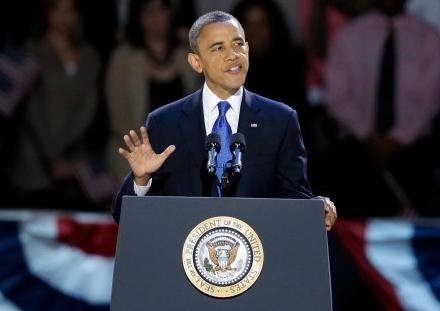
Political Advice from 1929 Holds True in 2012: America Votes to Uphold the Status Quo
Shortly before Republican Herbert Hoover was inaugurated as the 31st president of the United States of America on March 4, 1929,former Republican president Calvin Coolidge offered him some helpful advice. He told President-Elect Hoover that: “If you don’t say anything, you won’t be called on to repeat it.”

Eighty-three years later, President Coolidge’s advice could have described the mantra of the 2012 American presidential campaign, which ended on November 6. Democratic incumbent President Barack Obama defied the odds — both figuratively and historically — since he won a second term even with an unemployment rate of 7.9%, an unlikely result as only one previous president had been able to accomplish such a feat – Democrat President Franklin Delano Roosevelt who, in 1936, the seventh year of the Great Depression, won his second of four terms while the unemployment rate sat at 17%. Also, Republican President Ronald Reagan was reelected in 1984 at a time when America’s unemployment rate was 6% – but with the lingering recession of the early 1980s slowing down and with an economic recovery that was gaining momentum.
Despite the burden of a weak economy, crippling national debt, the impending “fiscal cliff” threatening the American economy should a deal with Congress not be reached before New Year’s Day, and the fact that upwards of three-quarters of Americans in countless opinion polls agreed that the country “is going in the wrong direction,” President Obama will return to the White House for four more years.
Obama’s win was historic for another reason: he is the first president to win a second term with a decreasing number of Electoral College votes. In terms of the popular vote results, Obama shed about 10 million votes compared to his win four years earlier. His winning majority dipped from 52.9% when he defeated Republican Senator John McCain to 50.4% when he defeated former Massachusetts Governor Mitt Romney on Election Day.
While a win may indeed be a win no matter by what margin it is won, all wins do not carry the same meaning, especially when the winner and the loser did not campaign on the specific details of their future tenure in the Oval Office. Both the Romney and Obama campaigns focused on wedge issues, distractions and divisive cultural issues that are of little importance, given the drastic fiscal challenges that America faces in the short term, as well as an economy that remains stuck in first gear.
Issues from access to contraception and abortion to funding Big Bird on daytime television’s Public Broadcasting Service (PBS) were discussed at great length. However, neither Obama nor Romney spent much time discussing the crucial issue that mattered most to Americans: how to fix America’s ailing economy. On this matter, Romney offered a five-point plan that hinged upon cutting regulatory red tape and tapping into America’s vast hydrocarbon deposits to boost the prospects of achieving North American energy independence and rejuvenating the broader economy.
Obama, on the other hand, offered a slick-looking campaign document entitled A Plan for Jobs and Middle Class Security that essentially attempted to repackage the older ideas and goals from his first term.
Class warfare was the calling card for what little tangible economic discussion was to be had throughout the election campaign. It centered on Romney’s refusal to raise income taxes on Americans and Obama’s persistent belief that most of America’s financial woes and deficit could easily be cured by raising income taxes on those earning more than $250,000 a year — despite the fact that many independent studies have shown that such a move would only generate marginal gains in revenue for the paying down of America’s $16 trillion debt. Consequently, instead of a detailed discussion on what both candidates envisioned for the American economy, the campaign devolved into a form of political trench warfare characterized by hundreds of widely broadcast virulent political advertisements intended to besmirch the opposing candidate. Even before Super Storm Sandy severely damaged the North Eastern Seaboard (thereby allowing the president to effortlessly appear as a bipartisan figure), the presidential campaign clearly demonstrated the advantage enjoyed by an incumbent who benefited from the changing demographics of American society. For instance, while Governor Romney spent months of his time and millions of his campaign’s dollars fighting fellow Republicans during his party’s grueling Primary Race, President Obama as an unopposed incumbent was able to focus much of his campaign’s financial and human resources on negatively defining Romney to the American public, on gathering extensive voter information and on developing a finely-tuned ground team that was able to tailor its broader campaign (and candidate) to the diverse demographic segments of the American populace. This paid dividends for the President on Election Day.
Romney, having been framed as a radically conservative candidate by Obama, lost the election primarily because of the changing face of 21st century America. Romney won the clear support of middle-aged and older Caucasian men, but lost the majority support of Caucasian women because of a number of outlandish remarks made by several congressional Republican candidates during the campaign. However, the vast majority of the fastest-growing demographic groups in America overwhelmingly voted for Obama rather than Romney. Hispanic-Americans contributed about one of every 10 votes in the election. Romney was only able to secure about 27% of their support, a sharp decline from the 44% that Republican George Bush won in the divisive 2000 presidential race. Much of this dearth of Hispanic-American support for Romney and his party grew out of what was generally considered to be Romney’s tougher stance on illegal immigration when compared to President Obama’s (or even that of former President George W. Bush).
Romney’s support in the African-American community was virtually nonexistent. With the percentage of Caucasian-American voters bound to slip below 70% in the next few years, the Republican Party faces difficult prospects in terms of winning back the presidency, should it be unable to broaden its appeal to voters in America’s increasingly larger ethnic minority groups.

Yet, despite the changing demographics of America and the challenges it may pose for the Republican Party, when considering the congressional and presidential election results in unison, 2012 was an election upholding the status quo in Washington. The Democrats kept control of the White House and the Senate, while the Republicans held on to the House of Representatives. Perhaps the return to the status quo (whatever it may be) should come as no surprise given the lack of meaningful discussion in the corridors of power in Washington, D.C. for several years. Then again: “If you don’t say anything, you won’t be called on to repeat it.”
No wonder Coolidge’s nickname was “Silent Cal.”













